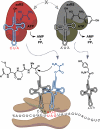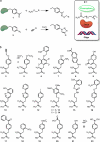Beyond the canonical 20 amino acids: expanding the genetic lexicon
- PMID: 20147747
- PMCID: PMC2856976
- DOI: 10.1074/jbc.R109.091306
Beyond the canonical 20 amino acids: expanding the genetic lexicon
Abstract
The ability to genetically encode unnatural amino acids beyond the common 20 has allowed unprecedented control over the chemical structures of recombinantly expressed proteins. Orthogonal aminoacyl-tRNA synthetase/tRNA pairs have been used together with nonsense, rare, or 4-bp codons to incorporate >50 unnatural amino acids into proteins in Escherichia coli, Saccharomyces cerevisiae, Pichia pastoris, and mammalian cell lines. This has allowed the expression of proteins containing amino acids with novel side chains, including fluorophores, post-translational modifications, metal ion chelators, photocaged and photocross-linking moieties, uniquely reactive functional groups, and NMR, IR, and x-ray crystallographic probes.
Figures


References
-
- Wang L., Xie J., Schultz P. G. (2006) Annu. Rev. Biophys. Biomol. Struct. 35, 225–249 - PubMed
-
- Noren C. J., Anthony-Cahill S. J., Griffith M. C., Schultz P. G. (1989) Science 244, 182–188 - PubMed
-
- Mendel D., Cornish V. W., Schultz P. G. (1995) Annu. Rev. Biophys. Biomol. Struct. 24, 435–462 - PubMed
-
- Martin A. B., Schultz P. G. (1999) Trends Cell Biol. 9, M24–M28 - PubMed
-
- Nowak M. W., Kearney P. C., Sampson J. R., Saks M. E., Labarca C. G., Silverman S. K., Zhong W., Thorson J., Abelson J. N., Davidson N., Schultz P. G., Dougherty D. A., Lester H. A. (1995) Science 268, 439–442 - PubMed
Publication types
MeSH terms
Substances
Grants and funding
LinkOut - more resources
Full Text Sources
Other Literature Sources
Molecular Biology Databases

